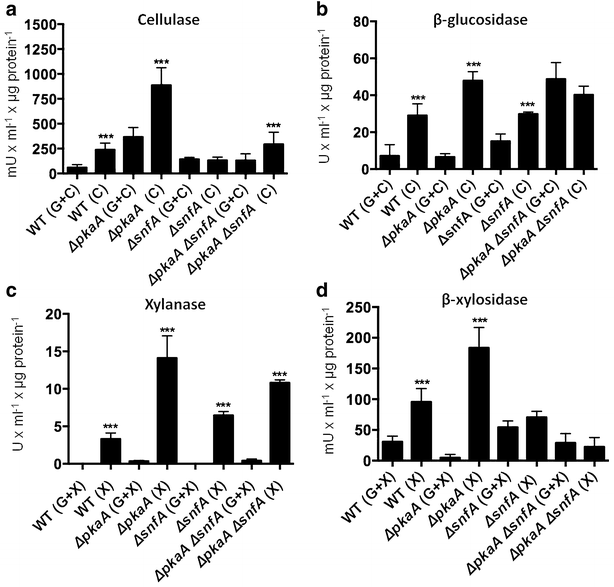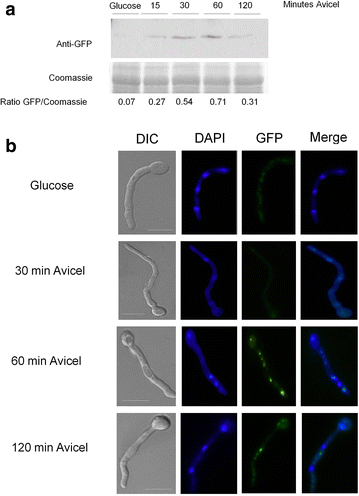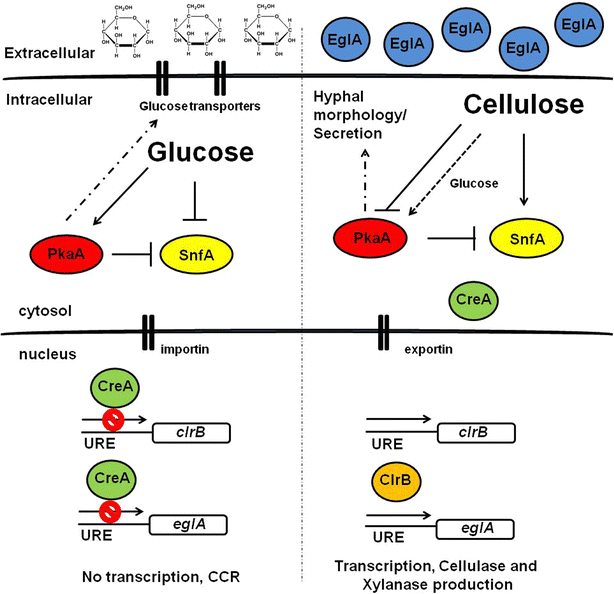Aspergillus nidulans protein kinase A plays an important role in cellulase production
- PMID: 26690721
- PMCID: PMC4683954
- DOI: 10.1186/s13068-015-0401-1
Aspergillus nidulans protein kinase A plays an important role in cellulase production
Abstract
Background: The production of bioethanol from lignocellulosic feedstocks is dependent on lignocellulosic biomass degradation by hydrolytic enzymes. The main component of lignocellulose is cellulose and different types of organisms are able to secrete cellulases. The filamentous fungus Aspergillus nidulans serves as a model organism to study cellulase production and the available tools allow exploring more in depth the mechanisms governing cellulase production and carbon catabolite repression.
Results: In A. nidulans, microarray data identified the cAMP-dependent protein kinase A (PkaA) as being involved in the transcriptional modulation and the production of lignocellulolytic enzymes in the presence of cellulose. Deletion of pkaA resulted in increased hydrolytic enzyme secretion, but reduced growth in the presence of lignocellulosic components and various other carbon sources. Furthermore, genes involved in fungal development were increased in the ΔpkaA strain, probably leading to the increased hyphal branching as was observed in this strain. This would allow the secretion of higher amounts of proteins. In addition, the expression of SynA, encoding a V-SNARE synaptobrevin protein involved in secretion, was increased in the ΔpkaA mutant. Deletion of pkaA also resulted in the reduced nuclear localization of the carbon catabolite repressor CreA in the presence of glucose and in partial de-repression when grown on cellulose. PkaA is involved in the glucose signaling pathway as the absence of this protein resulted in reduced glucose uptake and lower hexokinase/glucokinase activity, directing the cell to starvation conditions. Genome-wide transcriptomics showed that the expression of genes encoding proteins involved in fatty acid metabolism, mitochondrial function and in the use of cell storages was increased.
Conclusions: This study shows that PkaA is involved in hydrolytic enzyme production in A. nidulans. It appears that this protein kinase blocks the glucose pathway, hence forcing the cell to change to starvation conditions, increasing hydrolytic enzyme secretion and inducing the usage of cellular storages. This work uncovered new regulatory avenues governing the tight interplay between the metabolic states of the cell, which are important for the production of hydrolytic enzymes targeting lignocellulosic biomass. Deletion of pkaA resulted in a strain with increased hydrolytic enzyme secretion and reduced biomass formation.
Keywords: Aspergillus nidulans; Carbon catabolite repression; Cellulose; Glucose metabolism; Protein kinase A.
Figures








Similar articles
-
CreA-independent carbon catabolite repression of cellulase genes by trimeric G-protein and protein kinase A in Aspergillus nidulans.Curr Genet. 2019 Aug;65(4):941-952. doi: 10.1007/s00294-019-00944-4. Epub 2019 Feb 22. Curr Genet. 2019. PMID: 30796472
-
Regulation of Aspergillus nidulans CreA-Mediated Catabolite Repression by the F-Box Proteins Fbx23 and Fbx47.mBio. 2018 Jun 19;9(3):e00840-18. doi: 10.1128/mBio.00840-18. mBio. 2018. PMID: 29921666 Free PMC article.
-
Functional characterisation of the non-essential protein kinases and phosphatases regulating Aspergillus nidulans hydrolytic enzyme production.Biotechnol Biofuels. 2013 Jun 25;6(1):91. doi: 10.1186/1754-6834-6-91. Biotechnol Biofuels. 2013. PMID: 23800192 Free PMC article.
-
How nutritional status signalling coordinates metabolism and lignocellulolytic enzyme secretion.Fungal Genet Biol. 2014 Nov;72:48-63. doi: 10.1016/j.fgb.2014.06.012. Epub 2014 Jul 8. Fungal Genet Biol. 2014. PMID: 25011009 Review.
-
Cellulolytic enzyme production and enzymatic hydrolysis for second-generation bioethanol production.Adv Biochem Eng Biotechnol. 2012;128:1-24. doi: 10.1007/10_2011_131. Adv Biochem Eng Biotechnol. 2012. PMID: 22231654 Review.
Cited by
-
The High Osmolarity Glycerol Mitogen-Activated Protein Kinase regulates glucose catabolite repression in filamentous fungi.PLoS Genet. 2020 Aug 25;16(8):e1008996. doi: 10.1371/journal.pgen.1008996. eCollection 2020 Aug. PLoS Genet. 2020. PMID: 32841242 Free PMC article.
-
Regulating Strategies for Producing Carbohydrate Active Enzymes by Filamentous Fungal Cell Factories.Front Bioeng Biotechnol. 2020 Jul 8;8:691. doi: 10.3389/fbioe.2020.00691. eCollection 2020. Front Bioeng Biotechnol. 2020. PMID: 32733865 Free PMC article. Review.
-
Comprehensively dissecting the hub regulation of PkaC on high-productivity and pellet macromorphology in citric acid producing Aspergillus niger.Microb Biotechnol. 2022 Jun;15(6):1867-1882. doi: 10.1111/1751-7915.14020. Epub 2022 Feb 25. Microb Biotechnol. 2022. PMID: 35213792 Free PMC article.
-
Comprehensive Analysis of Aspergillus nidulans PKA Phosphorylome Identifies a Novel Mode of CreA Regulation.mBio. 2019 Apr 30;10(2):e02825-18. doi: 10.1128/mBio.02825-18. mBio. 2019. PMID: 31040248 Free PMC article.
-
Carbon Catabolite Repression in Filamentous Fungi.Int J Mol Sci. 2017 Dec 24;19(1):48. doi: 10.3390/ijms19010048. Int J Mol Sci. 2017. PMID: 29295552 Free PMC article. Review.
References
-
- DeBoy RT, Mongodin EF, Fouts DE, Tailford LE, Khouri H, Emerson JB, Mohamoud Y, Watkins K, Henrissat B, Gilbert HJ, Nelson KE. Insights into plant cell wall degradation from the genome sequence of the soil bacterium Cellvibrio japonicus. J Bacteriol. 2008;190:5455–5463. doi: 10.1128/JB.01701-07. - DOI - PMC - PubMed
LinkOut - more resources
Full Text Sources
Other Literature Sources
Molecular Biology Databases

